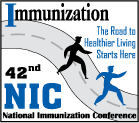
|
|
CDC NIP/NIC Home Page
|
Tuesday, March 18, 2008
123
Factors associated with higher rates of adolescent varicella immunity among enrollees of commercial health insurance plans
Barbara H. Bardenheier, NIP/ISD/HSREB, Centers for Disease Control and Prevention, 1600 Clifton Rd, NE, MS-E52, Atlanta, GA, USA, Aisha Jumaan, Child Vaccine Preventable Disease Branch, Epidemiology and Surveillance Division, National Immunization Program, Centers for Disease Control and Prevention, 1600 Clifton Rd, MS E-61, Atlanta, GA, USA, Shannon Stokley, National Center for Immunization and Respiratory Diseases, Centers for Disease Control and Prevention, 1600 Clifton Road, NE, MS E-52, Atlanta, GA, USA, and Walter A. Orenstein, Medical School, Emory University.
Learning Objectives for this Presentation:
By the end of the presentation participants will be able to identify factors associated with uptake of a new adolescent vaccine in the commercially insured population.
Background:
Varicella zoster virus (VZV) vaccination was recommended by the Advisory Committee on Immunization Practices (ACIP) in 1996 routinely for children aged 12-18 months or as a catch-up for susceptible children aged 19 months-12 years. By 2005, varicella disease has declined about 90% with evidence of herd immunity (lower circulation of the wild virus). No national data are available to assess VZV immunity in adolescents.
Objectives:
Use the Healthcare Effectiveness Data and Information Set (HEDIS®) to examine VZV immunity and factors associated with it over time.
Methods:
We used longitudinal regression analysis of an annual average of 400 commercial managed care organizations' HEDIS measures from 1998 to 2006 The outcome measure was the proportion of enrollees aged 13 years sampled in the plan that received varicella vaccine or had documentation of the illness. We examined adolescent preventive visits, childhood varicella immunization rates, and adolescent MMR and hepatitis B immunity rates as predictors of immunization.
Results:
In separate multivariable models controlling for confounders: 1) plans with the median or higher proportion of adolescent well visits had an average of 4 percentage points higher proportion of teen varicella immunity; 2) plans with the median or higher proportion of children aged 2 years immune to varicella had an average of 4.5 percentage points higher proportion of teen varicella immunity; and 3) plans with the median or higher proportion of teen MMR or hepatitis B immunity had an average of 6.16 and 6.12 percentage points higher proportion of teen varicella immunity, respectively.
Conclusions:
Plans performing in the top half of those reporting for adolescent well visits, childhood varicella immunization, and adolescent MMR and hepatitis B immunity had greater varicella immunity.
See more of Exhibit and Poster Viewing Session (and Break)
See more of The 42nd National Immunization Conference (NIC)
See more of The 42nd National Immunization Conference (NIC)